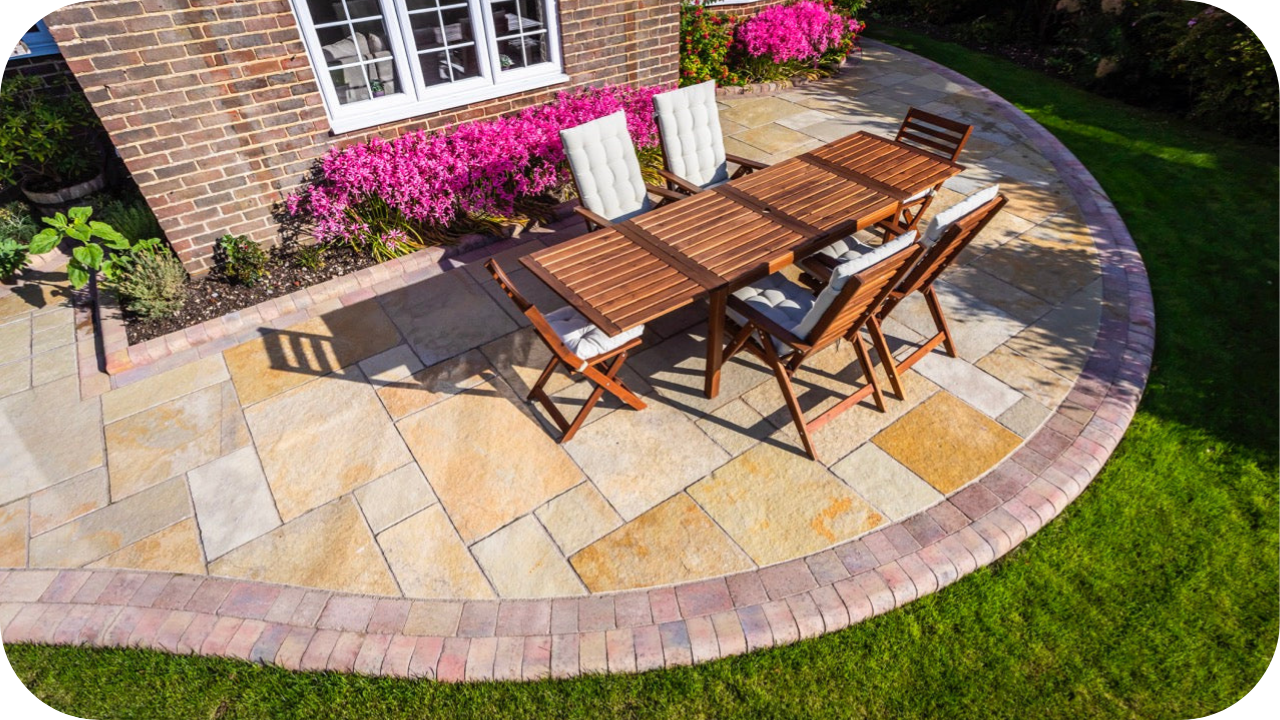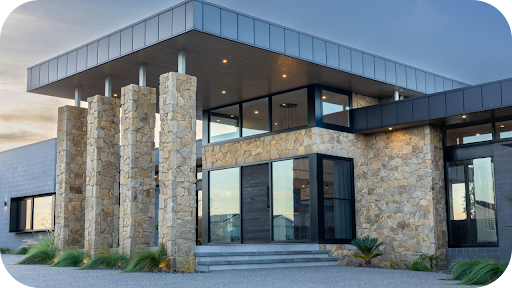
In passive design, the materials used in a building play a crucial role in regulating temperature. Natural stone pavers are ideal for enhancing thermal performance by leveraging their ability to absorb, store, and release heat.
By carefully selecting the right stone, you can reduce the need for mechanical heating and cooling, making your home more energy-efficient.
This article will highlight how stone pavers contribute to passive solar performance, offering both environmental benefits and improved comfort in modern architectural designs.
What Is Passive Design?
Passive design is an architectural approach that maximises natural resources, such as sunlight, airflow, and thermal mass, to maintain comfortable temperatures. By reducing reliance on mechanical heating and cooling, passive design promotes energy efficiency.
It involves careful consideration of factors such as building orientation, insulation, ventilation, shading, and the selection of materials that enhance the natural performance of a space, making it more sustainable and comfortable.
Key Thermal Properties of Natural Stone
Natural stone’s unique thermal properties make it ideal for passive design. Here are the key characteristics that contribute to its performance in regulating temperature and enhancing energy efficiency in your space.
1. High Density
Stone’s high density allows it to absorb and store substantial amounts of heat. This thermal mass helps regulate temperature fluctuations, ensuring a more stable and consistent indoor environment, reducing reliance on mechanical heating or cooling.
2. Low Thermal Conductivity
Natural stone has low thermal conductivity, meaning it resists the rapid transfer of heat. This provides excellent insulation, helping maintain comfortable temperatures inside, keeping spaces cool in summer and warm in winter without extra energy consumption.
3. Surface Reflectivity
Lighter-coloured stones reflect more heat, keeping outdoor areas cooler. Conversely, darker stones absorb and store heat, releasing it slowly over time to maintain warmth, offering a balance of energy efficiency and comfort in various climates.
4. Thermal Lag
Thermal lag refers to the delayed transfer of heat, which natural stone achieves naturally. This property enables stone to release stored heat during colder periods, offering warmth in the evening or during the night, enhancing comfort.
5. Moisture Retention
Stone’s ability to absorb and retain moisture also impacts its thermal performance. The moisture helps regulate temperature fluctuations by releasing
How Natural Stone Supports Passive Design Principles
Natural stone contributes significantly to passive design by enhancing thermal performance, promoting energy efficiency, and improving comfort. Below are key ways stone supports passive design principles.
1. Offers Thermal Mass Benefits
Stone absorbs and stores heat during the day, releasing it at night to regulate indoor temperatures. This natural ability helps reduce the need for mechanical heating, making spaces more energy-efficient.
2. Maximises Solar Gain
Placing stone in sunlit areas allows it to absorb and store heat, boosting thermal performance. This reduces reliance on artificial heating and helps maintain consistent indoor temperatures, enhancing comfort and sustainability.
3. Provides a Cooling Effect
Stone pavers naturally stay cool in shaded zones, reducing ambient heat. This cooling effect not only makes outdoor spaces more comfortable but also reduces the need for air conditioning in indoor areas.
4. Ensures Durability with Low Embodied Energy
Natural stone is incredibly durable, requiring minimal maintenance and replacement. Its long lifespan and low embodied energy make it a sustainable choice, supporting eco-friendly building practices and improving long-term performance.
5. Supports Natural Ventilation
Stone’s ability to absorb and release heat can support natural ventilation by helping regulate airflow. This balances indoor temperature fluctuations, reducing the need for artificial heating or cooling systems while maintaining comfortable air circulation.
Best Natural Stones for Passive Design Applications
Choosing the right stone for your paving layout is essential for enhancing thermal performance and energy efficiency. Here are the best stones for passive design and their optimal uses.
- Granite: Charcoal Granite with a flamed finish absorbs heat during the day and releases it at night. This makes it ideal for sun-exposed areas, providing temperature consistency in high-traffic zones.
- Limestone: Stamford Limestone with a smooth finish offers natural thermal mass, staying cool underfoot in shaded areas. It regulates temperature efficiently in warm climates, making it ideal for outdoor paths.
- Travertine: Ivory Travertine stays cool underfoot, making it perfect for pool surrounds. Silver Travertine provides a textured surface that reduces heat absorption, ensuring comfort on hot summer days outdoors.
- Bluestone: Flamed Bluestone stores heat, making it ideal for sun-facing areas, while Honed Bluestone remains cool and offers thermal lag, maintaining comfortable temperatures in areas exposed to sunlight.
- Quartzite: Andorra Quartzite, with a natural split finish, absorbs heat during the day and releases it at night. Its thermal properties ensure a comfortable outdoor environment in passive designs.
- Porphyry: Porphyry Cobbles have natural thermal mass and absorb heat efficiently. Their slow heat release helps maintain comfortable temperatures, especially in high-traffic outdoor areas exposed to sunlight.
- Marble: Ocean Grey Marble with a honed finish absorbs heat and gradually releases it, providing consistent temperature control, especially in sun-exposed areas, making it ideal for luxurious outdoor spaces.
Strategic Placement of Stone Pavers in Passive Designs
The placement of stone pavers is key to maximising their thermal benefits. Here are some strategic placements to enhance thermal performance in your passive design.
- North-Facing Courtyards: Place high thermal mass stones in north-facing courtyards to absorb sunlight and re-radiate heat during the evening, ensuring consistent warmth throughout the day and night.
- Shaded Outdoor Areas: Choose lighter or more porous stones, such as Travertine or Limestone, for shaded zones to maintain a cooler surface underfoot, reducing the need for mechanical cooling.
- Thermal Banks: Integrate pavers as heat banks adjacent to windows or thermal walls. This allows stones to absorb heat from sunlight during the day and release it into the interior at night.
- Indoor-Outdoor Continuity: Use the same stone for both indoor and outdoor areas. This maximises thermal mass in connected zones, ensuring seamless temperature regulation between indoor living spaces and external areas.
- Paths and Walkways: Create pathways with stones like Bluestone and Granite that absorb and store heat. These can provide warmth during cooler evenings, especially in high-traffic zones or transitional outdoor areas.
How to Combine Stone Pavers with Other Passive Design Elements
Stone pavers enhance the performance of passive design when used alongside other design elements. Here’s how to pair stone with complementary features to maximise thermal efficiency and comfort.
1. Incorporate Shading Devices
Add shading devices like pergolas or awnings to stone surfaces to reduce excessive heat absorption. This balances solar gain by providing shade during summer and allowing heat storage in cooler months, enhancing comfort.
2. Enhance Cross Ventilation
Maximise the cooling effect of cross ventilation by placing stone near ventilation openings. This allows the stone’s thermal mass to regulate indoor temperatures, improving airflow and reducing the need for air conditioning.
3. Orient Glazing Towards Stone
Position north-facing glazing next to stone paving to capture solar energy. This setup lets the stone absorb and release heat, aiding in temperature regulation and lowering heating costs by making the most of natural sunlight.
4. Use Insulated Substrates
Place stone pavers over insulated substrates to minimise ground heat loss. This keeps outdoor spaces warmer during cold weather and cooler in summer, improving thermal performance and enhancing passive design efficiency.
5. Integrate Water Features
Incorporating water features like ponds or fountains near stone pavers can improve passive cooling. Water evaporates, lowering the surrounding temperature, while stone’s thermal mass helps maintain a comfortable environment in all seasons.
Conclusion
Natural stone pavers not only enhance the aesthetic appeal of your outdoor spaces but also support passive design principles by improving temperature regulation and energy efficiency.
By thoughtfully combining stone with other design elements, you can create a comfortable, sustainable environment that reduces reliance on mechanical systems.
Contact Splendour in Stone for expert advice and premium stone solutions tailored to your passive design vision.
More To Explore

Grey Granite Cobblestones for Driveways: Strength and Style
Grey granite cobblestones combine strength, safety, and timeless appeal, making them a popular choice for Melbourne driveways and outdoor spaces. Their natural flamed texture offers

Granite Wall Cladding Melbourne: Modern and Classic Appeal
Granite wall cladding brings both modern sophistication and classic charm to Melbourne architecture. Known for its durability and natural beauty, granite transforms façades, feature walls,


